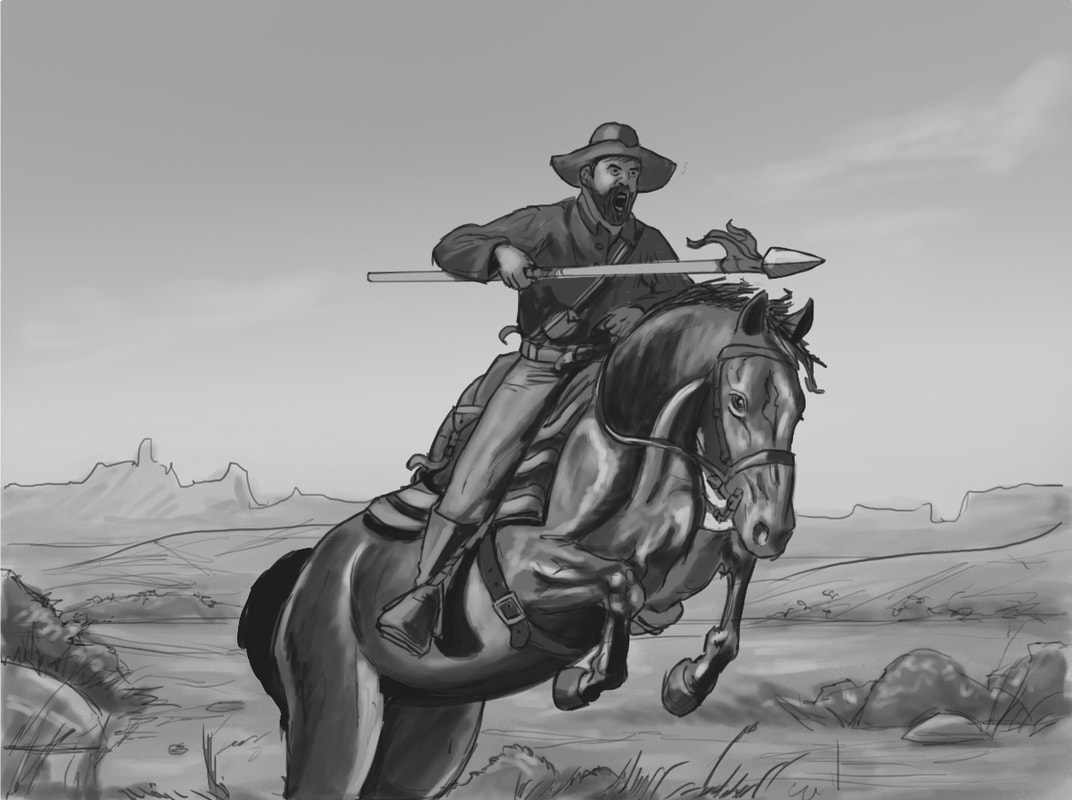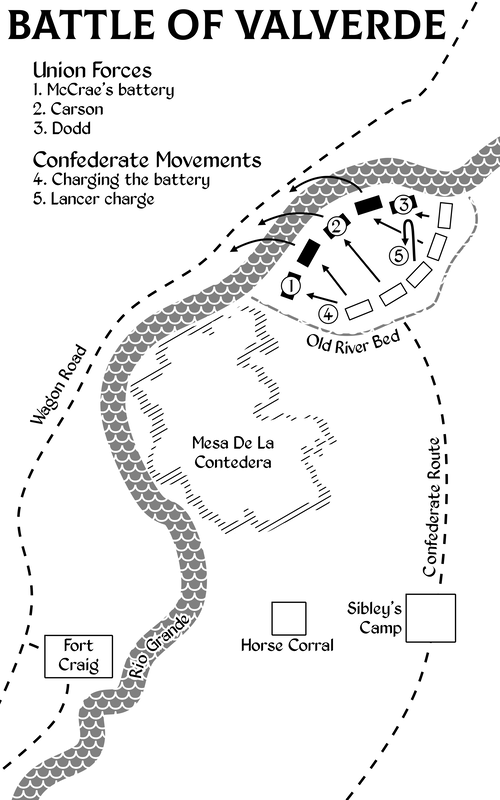 Brig. Gen H.H. Sibley Brig. Gen H.H. SibleyFebruary 21, 2022 is the 160th anniversary of the Battle of Valverde, the first major battle of the American Civil War fought in New Mexico territory. It was a Confederate success, but did not give the invading southern army the advantages it had hoped to attain with such a victory. On January 3, 1862, Confederate brigadier general, Henry Hopkins Sibley left El Paso with a little more than three regiments of mounted Texans. This brigade, which he called the Confederate Army of New Mexico, totaled 2,510 officers and men. He headed north, with the intention of defeating the Union forces at Fort Craig, capturing the capital city of Santa Fe, taking the heavily provisioned Fort Union, and then marching into Colorado to take control of the gold and silver mines before finally heading westward to conquer California. If his plan had succeeded, Sibley would have fulfilled the Confederacy’s dreams of Manifest Destiny while giving the south warm water ports on the Pacific and a huge boost to its treasury.  Col. E.R.S. Canby Col. E.R.S. CanbyFort Craig, 140 miles north of El Paso, was the first obstacle in Sibley’s path, and taking it was an important objective. Sibley’s army traveled light, with the hope of acquiring food, arms, ammunition, and other supplies as they went. He needed the provisions within Fort Craig to replenish his already dwindling supplies. However, Colonel Edmund R.S. Canby, the commander of Federal troops in New Mexico, was hunkered down in the fort, waiting with 3,800 men. Only 1,200 of Canby's men were professional soldiers. The remainder were militia and volunteers from New Mexico and Colorado. Kit Carson, the famous Indian fighter, mountain man and scout, commanded the largely Hispanic First Regiment of New Mexican volunteers. Sibley arrived at Fort Craig in the middle of February. Scouts, fooled by Canby’s use of “Quaker cannons,” logs painted black to imitate artillery pieces, reported that the fort was too heavily fortified to be taken. Hoping to lure the Federals into the open, Sibley moved his men into an arroyo south of the fort. The cautious Canby refused to be provoked.  The black line on the horizon is Contadoria Mesa. The battle happened just to the left of it. The black line on the horizon is Contadoria Mesa. The battle happened just to the left of it.When the Confederate supplies could only hold out for a few more days, Sibley decided to abandon his plan to take the fort. Instead, he decided upon a “roundance on Yankeedom,” in which he would cross to the east side of the Rio Grande, flank the fort under cover from surrounding hills, including Contadoria Mesa, then recross the Rio Grande at Valverde ford, six miles north of Fort Craig and continue on to the town of Socorro. Sibley planned to be able to cut Union communications between the fort and their headquarters in Santa Fe this way, making further conquests more achievable.  Lt. Colonel William Read Scurry Lt. Colonel William Read ScurryOn the morning of February 21, Sibley sent an advance party consisting of four companies of the Major Charles Pyron’s 2nd Texas Mounted Rifles and Lieutenant Colonel William Read Scurry’s 4th Texas Mounted Rifles to scout the ford at Valverde. To their surprise, Canby had anticipated their move and had secured the ford with cavalry commanded by Major Thomas Duncan. The Texans took cover in an old river bed, which served as an excellent defensive position, with Scurry to Pyron's right, and their artillery on their left. The Confederates possessed numerical superiority, but were armed with short range shotguns and pistols which could not reach the Union positions three hundred yards away. The Confederate howitzers also could not reach the Union artillery, which had remained on the western bank of the river. As the day progressed, more soldiers arrived on both sides of the battle line. Colonel Benjamin S. Roberts reinforced the Union cavalry with the 5th New Mexico Infantry. When Colonel Canby arrived with most of Fort Craig’s remaining garrison, he ordered all but First New Mexico Volunteers under Carson and the Second New Mexico Volunteers under Colonel Miguel Piño to cross to the eastern side of the river.  Maj Lockridge Maj LockridgeThe remainder of the Confederate force, the 5th Texas Mounted Rifles under Colonel Thomas Green and a battalion of the 7th Texas Mounted Rifles under Lieutenant Colonel John Sutton, arrived at the battlefield early that afternoon. Sibley, who had fallen ill, most likely from drinking too much, relinquished command of the brigade to Green, who then handed over command of the 5th Texas over to Major Samuel Lockridge.  Illustration by Ian Bristow in Where Duty Calls. Illustration by Ian Bristow in Where Duty Calls.Around 2:00 pm, Green authorized the first and last lancer charge of the American Civil War. Using lances they had captured from Mexico during the Mexican-American war, the lancers charged what they thought was an inexperienced company of New Mexico volunteers on the Union extreme right. They expected the New Mexicans to break and run. However, the Union soldiers were actually a company of rough and tumble Colorado miners, who withstood the charge. Twenty of the lancers and almost all of the horses were killed or wounded.  An etching from a Harper's Weekly showing McRae defending his guns. An etching from a Harper's Weekly showing McRae defending his guns.By 4:00 p.m., when the Union appeared to have the advantage, Canby shifted his lines in order to attack the Confederate left. He ordered one of his batteries and several of his companies, including Carson's First New Mexico Regiment, to cross the river on his right. Unfortunately, weakened the center of the Union line, which Green then attacked with three successive waves which managed to overwhelm the Union guns. Samuel Lockridge, who led the charge and Alexander McRae, who commanded the guns, were both killed, and six Union artillery pieces were captured as the Union battle line crumbled into a panic-stricken retreat across the river. Canby then sent out a white flag, asking for time to remove the dead and wounded from the battlefield, and moved his forces back into Fort Craig.  Illustration by Ian Bristow, from Where Duty Calls. Illustration by Ian Bristow, from Where Duty Calls.Since the Union left the Confederate forces in possession of the battlefield, the Battle of Valverde is technically a Confederate victory. However, it was a Pyrrhic victory at best. The Confederates suffered sizable casualties: 36 killed, 150 wounded, and one missing out of their 2,590 men. They did not capture the fort’s supplies, which they desperately needed. And although they did cut Fort Craig off from their forces in the north, the Confederate supply chain to El Paso was also severed. Finally, the Texans had lost so many horses and mules in the battle and the days preceding it that the 4th Texas cavalry had to dismount and become infantry and some of the Confederate supply wagons had to be abandoned. These loses, plus those which were to occur in the mountains east of Santa Fe a month later caused the Army of New Mexico to turn back to Texas before they fulfilled their goal. Sibley’s army had won the battle, but lost their war.  The climax of Jennifer Bohnhoff’s novel Where Duty Calls occurs at the Battle of Valverde. Where Duty Calls is the first in a trilogy of novels set in New Mexico during the Civil War and written for middle grade readers. It is scheduled to be published by Kinkajou Press, a division of Artemesia Publishing, on June 14, 2022. It is available here. Jennifer Bohnhoff is a former New Mexico history teacher. The native New Mexican lives in the mountains east of Albuquerque. |






No comments:
Post a Comment